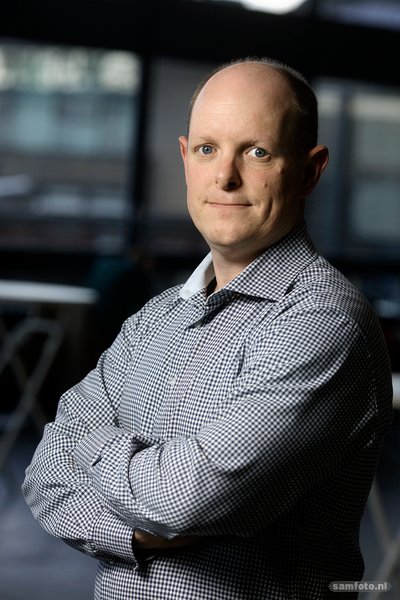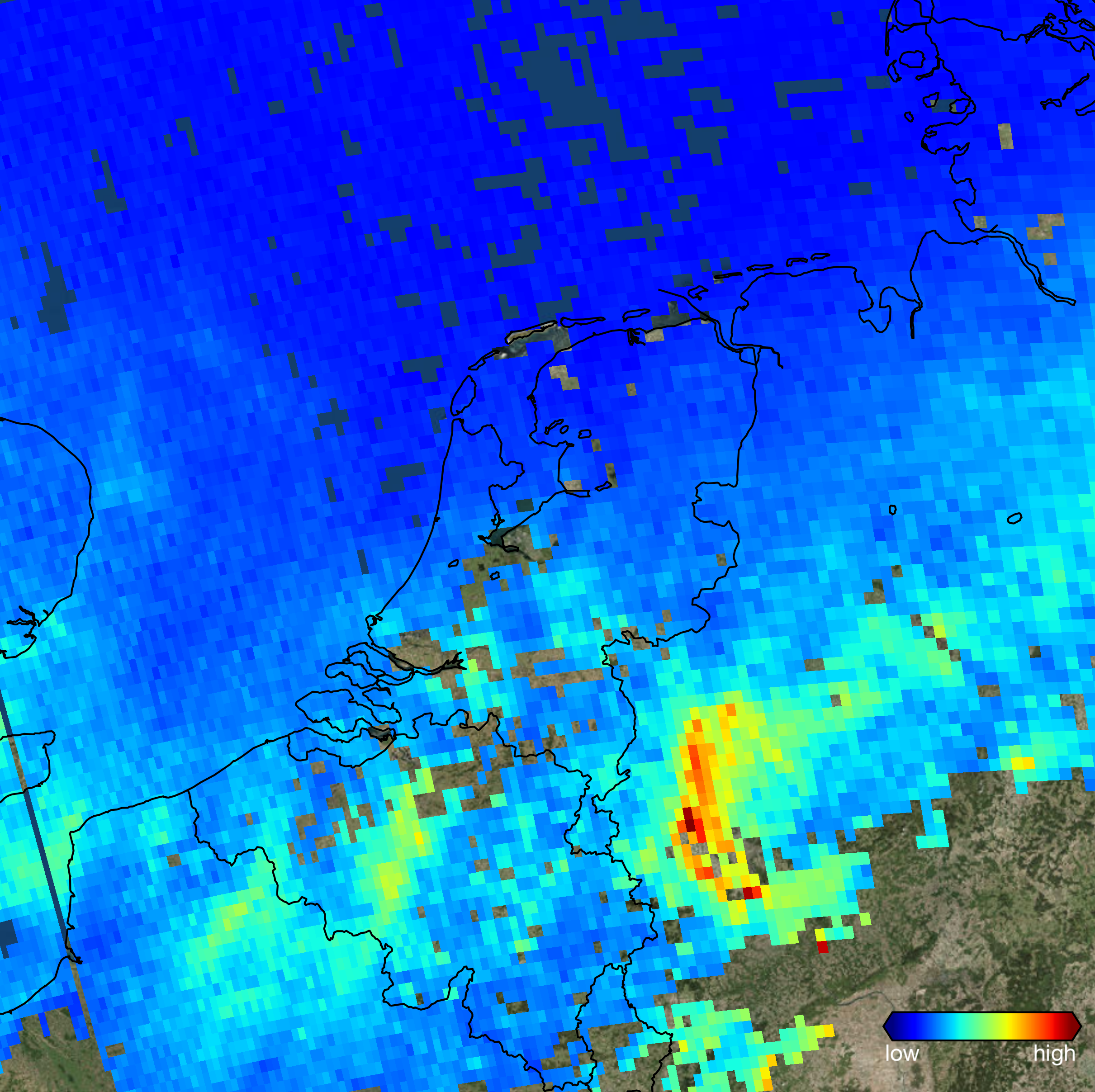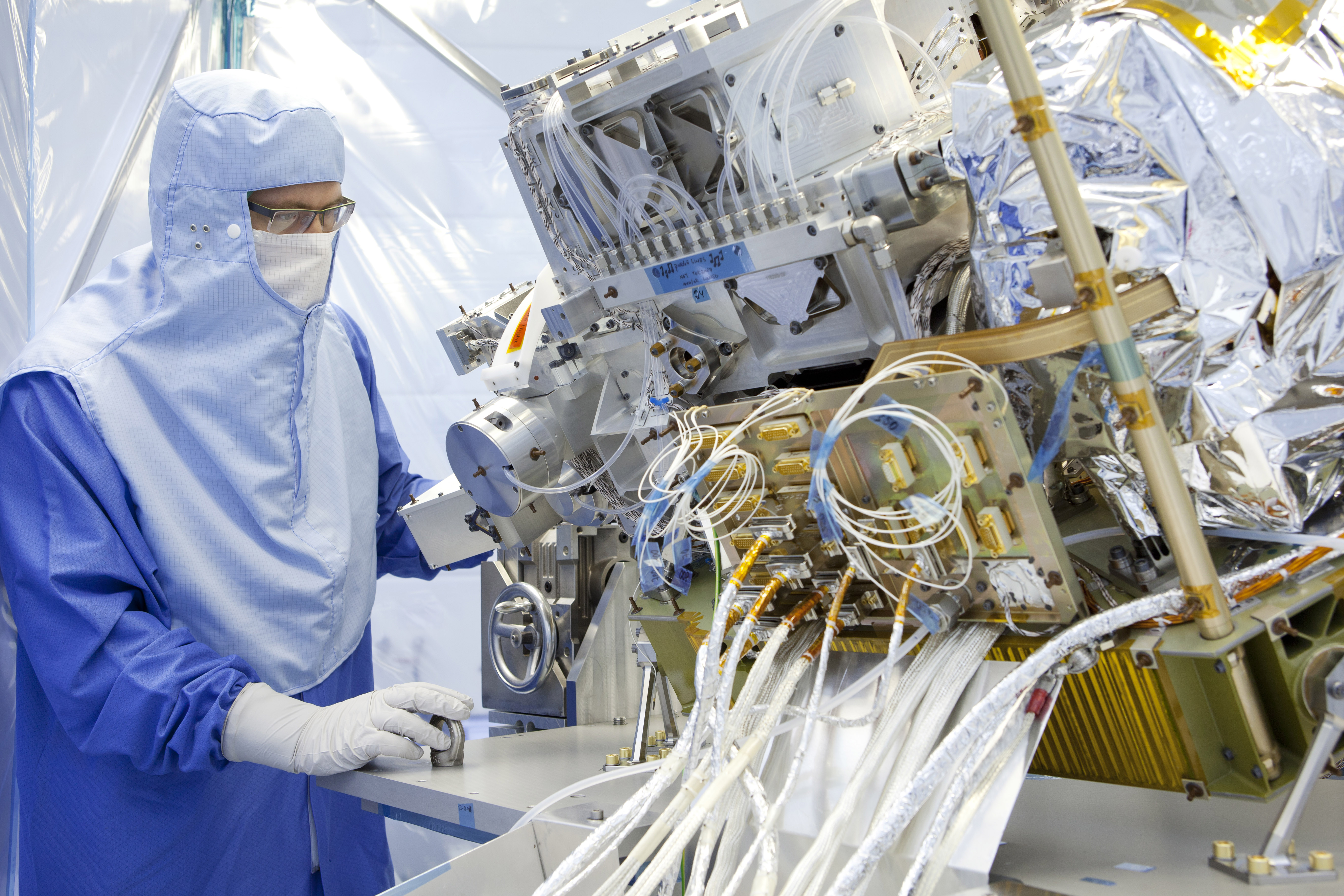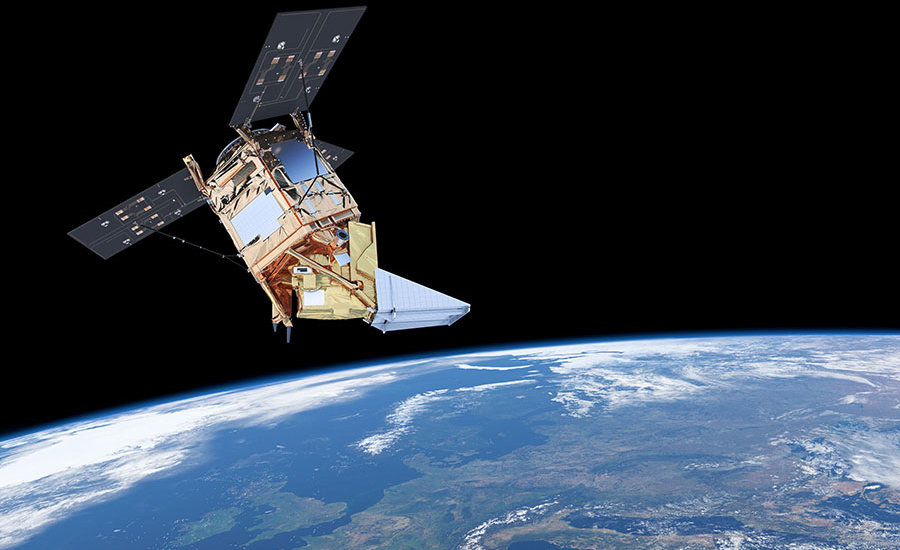A small wide-angle washing machine
Tropomi tracks global air pollution with unprecedented precision. KNMI and TU Delft researchers Pieternel Levelt and Pepijn Veefkind were at the conception of this satellite instrument. “We can now model plumes of nitrogen dioxide back to the chimney they came from.”
A large red patch defaces Russia. ‘Which city could that be?’ Professor of Atmospheric Remote Sensing Pieternel Levelt wonders, clearly disturbed by so much nitrogen dioxide (NO2) pollution.
We zoom in. It’s Novosibirsk. We fly on towards America. On the way, we see plumes of carbon dioxide in North India, skirting the Himalayas on their way towards China. And on to Mexico City. The metropolis is coloured purple with NO2.
“There's still so much to discover,” says Levelt, as she and Dr Pepijn Veefkind reveal some of the first images made with Tropomi last November. Both researchers work for the national meteorological institute KNMI and have part-time jobs in the Faculty of CEG.
The TROPOspheric Monitoring Instrument was launched into space on 13 October on board the European Sentinel-5P satellite, built by ESA as part of the Copernicus European Earth observation project.
The instrument measures the concentrations of dozens of gases in the atmosphere. Scientific management of the project is in the hands of KNMI and SRON. The instrument was built by Airbus and TNO.
The satellite orbits the Earth from pole to pole at an altitude of around 800 km 14.5 times a day. It observes a different part of the planet during each orbit.
Tropomi is the successor to OMI, an instrument that has been orbiting the Earth since 2004, and for which Levelt is the principal investigator. Levelt: “OMI still has the longest series of recordings of nitrogen dioxide and sulphur dioxide in the atmosphere and has given us almost fourteen years of excellent service.”

Photo (c) Sam Rentmeester
Pieternel Levelt: “The Copernicus project ensures data continuity but it has a clear operational and commercial mission.”
Ten times higher resolution
There are several important differences between OMI and Tropomi. The resolution of the new instrument is ten times higher, which gives researchers new possibilities. Levelt: “Tropomi has a spatial resolution of 3.5 by 7 kilometres, allowing us to identify various sources of air pollution.”
'We can trace an NO2 plume back to the individual polluter'

Photo (c) Sam Rentmeester
Pepijn Veefkind: “It only started to be fun after three years.”
Levelt shows me her computer images of the Netherlands. We see red swathes of NO2 over the Randstand, similar to Novosibirsk but less intense. “These are the images from one day. If we average out the data from several days, we get a higher resolution and we can distinguish the pollution above the Port of Rotterdam from pollution above the city.”
“If we then construct models, we can trace an NO2 plume back to the individual polluter, for example a power plant. You can even model the plume back to a specific chimney, as it were. It's information that will benefit policy-makers.”
The extra resolution is down to Tropomi's larger optical components. The optical part of OMI is the size of two shoe boxes. In Tropomi, it’s the size of a small washing machine.
Tropomi also has a wider angle. Projected onto the Earth's surface, it can scan a width of 2,600 km. “That's the equivalent of 120 degrees,” explains Levelt. She stands up and stretches her arms out to demonstrate the angle. “This is how Tropomi moves from pole to pole. We call this configuration the Swath.” The professor walks around the room with her arms outstretched, as if imitating a bird.
The instrument also measures two important greenhouse gases: methane and ozone. There is a lot of uncertainty about the levels of ozone in the troposphere. And methane is shrouded in mist. There are numerous sources of the gas: livestock farming, rice fields, wetlands, rubbish dumps, oil and gas fields, and melting permafrost. Little is known about how much gas the various sources emit.
Researchers were thinking about a successor as early as 2003, before the launch of OMI. “The normal life expectancy of a satellite instrument is about six years,” says Veefkind. “That's also about how long it takes to design and develop a new one, so we started on the next model immediately.”
Levelt was the principal investigator for OMI and for Tropomi. In 2009, she handed the reins to Veefkind, when she was appointed head of R&D satellite observations at KNMI. The two have been working together for fifteen years.
Launch
On Friday 13 October at 13.00 (local time at the launchpad in Plesetsk, Russia) Tropomi, on board the Sentinel-5P, was launched into space with a Russian Rockot, the thirteenth version of this type of rocket. The number thirteen plays a big part in Tropomi’s history. So much so that people wondered whether it would be better to postpone the launch. “Even scientists can be superstitious,” Levelt says, laughing.
After the launch, the satellite disappeared from the ESA radar for 90 minutes. After its first orbit of the Earth, a Swedish ground station picked up a signal. A streak of interference was projected onto a huge white screen at ESA-ESTEC in Noordwijk. And then a tiny peak appeared in the interference.
“There was a lot of cheering,” says Levelt. “We were so relieved.” Veefkind: “You need to realise that the Russians have different customs and practices. To begin, they don´t have a countdown. They just fire their rockets into space when they´re ready. And then you hear nothing more from them.”
The KNMI researchers got their first measurements a month later. The instrument measures spectral lines in the atmosphere. Each gas absorbs light of a particular wavelength in its own special way. By measuring the spectra – four thousand colours of the rainbow – and looking for dips in the spectral lines, the researchers can work out the concentrations of different gases.
“The measurements proved to be highly accurate,” says Veefkind.
'This project isn't a theoretical exercise; we're building a real instrument'
“Especially when you consider that the instrument had to cool down. Tropomi was heated up immediately after the launch, a protocol to repel contamination on the optical surfaces. After heating, a system was activated to cool the instrument down again. A door in the satellite had to be opened. It was a success, but obviously a very tense moment.”
Years of lobbying
In fact, there was no shortage of excitement in the Tropomi saga. In 2008, the team got the go-ahead to develop the satellite. This was after years of lobbying.
The Dutch government provided most of the funding: some €100 million spread across fifteen years. Levelt: “The decision was finally made by the then Minister of Economic Affairs, Maria van der Hoeven, responsible for space travel. It was time to pop the champagne. The Minister and I were both interviewed by the media. After all, it’s a major project.”
The Netherlands can't launch a satellite of this calibre on its own. We need help from organisations like ESA and NASA. “We worked hard on lots of different projects to get this instrument onto a mission,” says Levelt. “There's never any shortage of good ideas, but only a fraction of them actually make it.”

Image (c) KNMI
This computer animation shows clearly the pollution above the Ruhrgebiet.
ESA finally agreed to let Tropomi be part of the Copernicus Earth observation programme and the instrument was fitted to the Sentinel-5P satellite. Following on from Tropomi, two more Sentinel satellites will be launched into space in the next two years, with instruments for monitoring the chemistry of the atmosphere.
“It´s great being part of the Copernicus project,” continues Levelt. “It ensures data continuity. But it also means that we have to take a step back. OMI and Sciamachy (a spectrometer on board ESA’s Envisat mission in 2002-2012, ed.) were part of purely scientific satellite missions. Scientists were the only ones operating the buttons. Copernicus, on the other hand, has a clear operational and commercial mission. The idea is for companies to develop services such as rain radar, focusing on the chemical side of the weather.”
Emotional
Back to 2008. The funding was in place. “We then entered a long period of design work and document reviews,” says Veefkind. “It only started to be fun after three years. That’s when you start building. Milling pieces of aluminium.”
Levelt: “If you want to do this work properly, you must have affinity with the actual job of constructing satellite instruments. I did a lot of experimental optical work during my PhD research. My background made it easier to understand the problems facing the industry. This project isn't a theoretical exercise; we're building a real instrument. It's fantastic. I can get quite emotional about it.”
“In the clean room at TNO in Delft, we watched as the first contours of the optical part of the instrument appeared,” says Veefkind. “In the years that followed, we travelled around Europe in the wake of Tropomi. We did some calibration measurements in Liege. The instrument was then taken to Toulouse for a vibration test to see whether it could withstand the intense vibrations during launch. The next stop was Germany for acoustic tests, followed by an Airbus factory in England, where Tropomi was screwed into the satellite. Finally, we went to Russia for the launch itself.”
Levelt: “It's like saying goodbye to a child.” Veefkind: “We do still have a copy of Tropomi's on-board computer here on Earth. If we think up new monitoring settings, we can test them here first.”
KNMI will release all the measurements from Tropomi at the end of June. Everyone will be able to download the data with just a couple of hours delay.
“The satellite measures spectral lines,” explains Veefkind. “They are not direct pollution measurements. We use highly complex algorithms to convert the spectral lines into practical pollution data. We will make sure that everyone (climate researchers, epidemiologists and policy-makers) will have access to data they can understand.”

